Adding and subtracting fractions with unlike denominators is a fundamental math skill that requires finding common denominators. Mastering this concept enhances problem-solving abilities in real-life scenarios‚ such as cooking or budgeting. Practice with worksheets ensures proficiency in converting and simplifying fractions‚ building a strong foundation for advanced math topics. Regular practice with PDF resources helps students gain confidence and accuracy in their calculations.
What Are Unlike Denominators?
Unlike denominators refer to fractions that have different denominators‚ or bottom numbers‚ which make direct addition or subtraction impossible. For example‚ in the fractions 1/2 and 3/4‚ the denominators 2 and 4 are unlike. When fractions have unlike denominators‚ they cannot be combined until their denominators are made the same. This requires finding a common denominator‚ often the least common multiple (LCM) of the two denominators. Understanding unlike denominators is crucial for mastering fraction operations‚ as they frequently appear in real-world applications like cooking‚ shopping‚ and crafting. Worksheets provide structured practice to help students confidently work with unlike denominators‚ ensuring they can solve problems accurately and efficiently. Regular practice with such exercises builds a strong foundation in fraction skills.
Why is it Important to Learn Adding and Subtracting Fractions with Unlike Denominators?
Mastering the ability to add and subtract fractions with unlike denominators is essential for building a strong foundation in mathematics. This skill is fundamental for solving more complex problems in algebra‚ geometry‚ and real-world applications. Understanding how to work with unlike denominators enhances critical thinking and problem-solving abilities. In everyday life‚ fractions are used in cooking‚ budgeting‚ and crafting‚ where precise measurements are crucial. Worksheets provide structured practice‚ helping students develop accuracy and confidence. By learning this concept‚ students can tackle a variety of mathematical challenges with ease‚ preparing them for advanced topics and practical scenarios. Regular practice ensures long-term retention and fluency in fraction operations.

Step-by-Step Guide to Adding Fractions with Unlike Denominators
Identify the denominators‚ find the LCD‚ convert fractions‚ and add numerators. Simplify the result for the final answer. Practice with worksheets for mastery and confidence.
Identify the denominators of the fractions
Begin by examining the fractions involved in the problem. The denominator is the number below the fraction bar‚ indicating the total number of equal parts. For example‚ in the fraction 3/4‚ the denominator is 4. When adding fractions with unlike denominators‚ identifying the denominators is the first crucial step. This step ensures that you recognize the need to find a common denominator. Without identifying the denominators‚ you cannot proceed to the next steps of finding the least common denominator (LCD) and converting the fractions. Always double-check the denominators to avoid confusion and ensure accuracy in your calculations. This foundational step is essential for mastering the process of adding fractions with unlike denominators.
Find the Least Common Denominator (LCD)
To add or subtract fractions with unlike denominators‚ you must first find the Least Common Denominator (LCD). The LCD is the smallest number that both denominators can divide into evenly. For example‚ if the denominators are 4 and 6‚ the LCD is 12. One way to find the LCD is to list the multiples of each denominator until you find the smallest common multiple. Alternatively‚ you can use prime factorization to determine the LCD by multiplying the highest powers of all prime factors involved. Finding the LCD is crucial because it allows you to convert fractions to equivalent fractions with the same denominator‚ enabling accurate addition or subtraction. Always ensure the LCD is the smallest possible number to simplify calculations.
Convert Fractions to Equivalent Fractions with the LCD
Once you have the LCD‚ the next step is to convert each fraction into an equivalent fraction with the LCD as the denominator. To do this‚ multiply both the numerator and the denominator of each fraction by the same number to reach the LCD. For example‚ if the LCD is 12 and one fraction has a denominator of 4‚ multiply both the numerator and denominator by 3 to get an equivalent fraction with a denominator of 12. Repeat this process for all fractions involved in the problem. This step ensures that all fractions have the same denominator‚ making it possible to add or subtract the numerators directly. Accurate conversion is essential for correct results. Always double-check your calculations to avoid errors. This process simplifies the addition or subtraction process significantly. Ensure all fractions are properly aligned to the LCD before proceeding. This step is critical for maintaining the integrity of the math operation. Proper conversion ensures that the value of the original fractions is preserved‚ allowing for accurate addition or subtraction. By following this step carefully‚ you can avoid common mistakes and achieve the correct result. This method applies to both addition and subtraction of fractions with unlike denominators‚ ensuring consistency in your calculations. Always verify that the equivalent fractions are correctly formed before performing the operation. This attention to detail will help build a strong foundation in fraction operations.
Add the Numerators
After converting the fractions to equivalent fractions with the LCD‚ the next step is to add the numerators while keeping the denominator the same. For example‚ if you have 1/4 and 3/4‚ after converting to the LCD of 4‚ you add the numerators: 1 + 3 = 4‚ resulting in 4/4. This step is crucial as it allows you to combine the fractions into a single fraction. Always ensure the denominators remain unchanged during this process. Simplify the result if possible‚ such as 4/4 becoming 1. This straightforward step is where the actual addition happens‚ leading to the final result. Properly adding the numerators ensures accuracy in your solution. Double-check your work to avoid mistakes in this critical step.
Simplify the Result
Simplifying the result is the final step in adding fractions with unlike denominators. After adding the numerators‚ reduce the fraction to its simplest form by dividing both the numerator and the denominator by their greatest common divisor (GCD). For example‚ if the result is 8/12‚ divide both by 4 to get 2/3. Always check if the fraction can be simplified further. If the result is an improper fraction‚ consider converting it to a mixed number for clarity. Proper simplification ensures the answer is accurate and easy to understand. This step is crucial for maintaining precision in mathematical problem-solving. Remember‚ simplifying is not optional—it’s essential for clear and correct results.
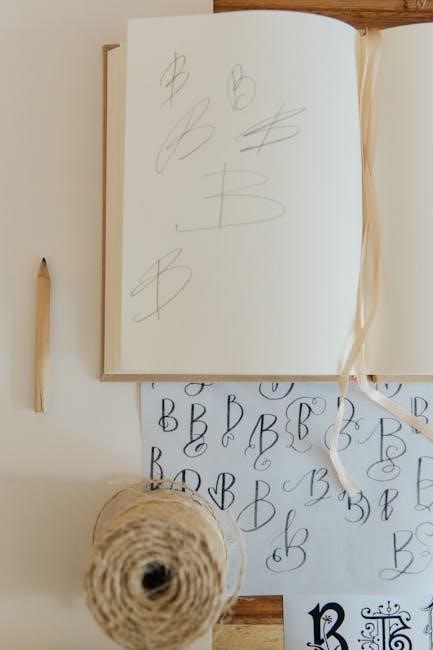
Step-by-Step Guide to Subtracting Fractions with Unlike Denominators
Subtracting fractions with unlike denominators involves finding a common denominator‚ converting fractions‚ and then subtracting numerators. Simplify the result for accuracy and clarity.
Ensure the Denominators are the Same
The first step in subtracting fractions with unlike denominators is to ensure both fractions have the same denominator. This requires finding a common multiple of the two denominators‚ typically the least common multiple (LCM). Once identified‚ convert each fraction to an equivalent fraction with the common denominator by multiplying the numerator and denominator by the necessary factor. For example‚ to subtract 1/4 from 3/6‚ first convert 3/6 to 1/2 by simplifying‚ then find a common denominator‚ which is 4. Convert 1/2 to 2/4‚ and now subtract 1/4 from 2/4 to get 1/4. This step ensures that the fractions are compatible for subtraction‚ allowing for accurate calculation and simplification of the result. Proper alignment of denominators is crucial for avoiding errors in the final answer.
Subtract the Numerators
Once the denominators are the same‚ subtract the numerators directly while keeping the denominator unchanged. For example‚ if you have fractions like 7/12 and 5/12‚ subtract 5 from 7 to get 2‚ resulting in 2/12. Simplify the fraction if possible. When dealing with unlike denominators‚ ensure they are converted to equivalent fractions with a common denominator before performing the subtraction. This step is crucial for maintaining accuracy in the result. Always remember to simplify the final fraction to its lowest terms to present the answer in the simplest form. Proper subtraction of numerators ensures the solution is correct and easy to understand.
Simplify the Fraction
Simplifying the fraction is the final step after adding or subtracting. To simplify‚ divide both the numerator and the denominator by their greatest common divisor (GCD). For example‚ if the result is 4/8‚ divide both by 4 to get 1/2. Always check if the fraction can be reduced further. If the numerator and denominator have no common factors other than 1‚ the fraction is already in its simplest form. Proper simplification ensures the answer is clear and concise‚ making it easier to interpret and use in further calculations. Regular practice with worksheets helps develop this skill efficiently.
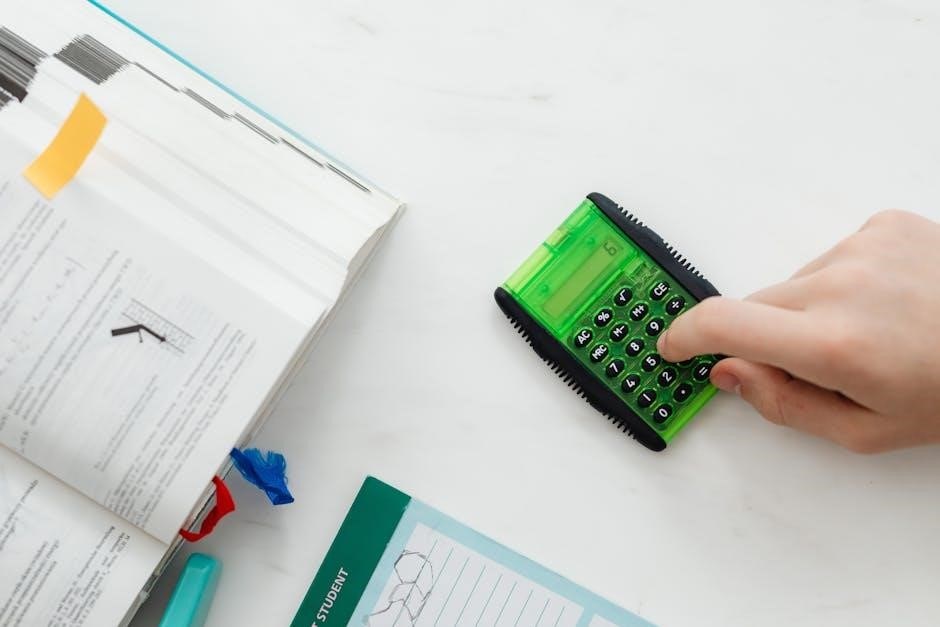
Worksheets for Practicing Adding and Subtracting Fractions with Unlike Denominators
Free printable PDF worksheets are available online‚ offering targeted practice for adding and subtracting fractions with unlike denominators. These resources‚ found on sites like Math Worksheets 4 Kids‚ provide clear instructions and answers for grade 4-6 students. Regular use of these worksheets ensures mastery of the concept through consistent practice and immediate feedback.
Where to Find Free Printable Worksheets
Free printable worksheets for adding and subtracting fractions with unlike denominators are widely available online. Websites like Math Worksheets 4 Kids and EffortlessMath.com offer a variety of PDF resources. These worksheets are designed for grades 4-6 and include problems for both proper and improper fractions. Many websites provide answer keys‚ making it easy for students to check their work. Additionally‚ platforms like Kuta Software and Corbettmaths offer customizable worksheets and video tutorials for extra support. Users can download these resources directly to their devices‚ ensuring convenient access to practice materials. These worksheets cater to different skill levels‚ from basic addition to complex mixed-number operations‚ helping students master the concept step-by-step.
How to Use Worksheets Effectively
To use worksheets effectively for adding and subtracting fractions with unlike denominators‚ start by introducing the concept with step-by-step guides. Begin with simpler problems to build confidence. Use the answer keys provided with most PDF worksheets to check progress and identify areas needing improvement. Incorporate real-world examples‚ such as cooking measurements‚ to make learning relatable. Encourage students to work independently but provide guidance when needed. Regular practice with varied worksheet exercises helps reinforce skills and ensures mastery. For advanced learners‚ gradually introduce mixed numbers and complex denominators to challenge their understanding. Consistent practice with these resources fosters a strong foundation in fraction operations‚ preparing students for higher-level math.
Benefits of Using Worksheets for Practice
Worksheets provide a structured and focused way to practice adding and subtracting fractions with unlike denominators. They offer clear examples and exercises tailored to specific skills‚ helping students build confidence and fluency. Regular use of worksheets reinforces key concepts‚ such as finding common denominators and simplifying results. They also allow students to work independently‚ fostering self-assessment and accountability. Additionally‚ worksheets enable parents and teachers to track progress and identify areas where extra support may be needed. With immediate feedback from answer keys‚ students can quickly learn from mistakes. Overall‚ worksheets are an essential tool for mastering fraction operations in a systematic and engaging manner.
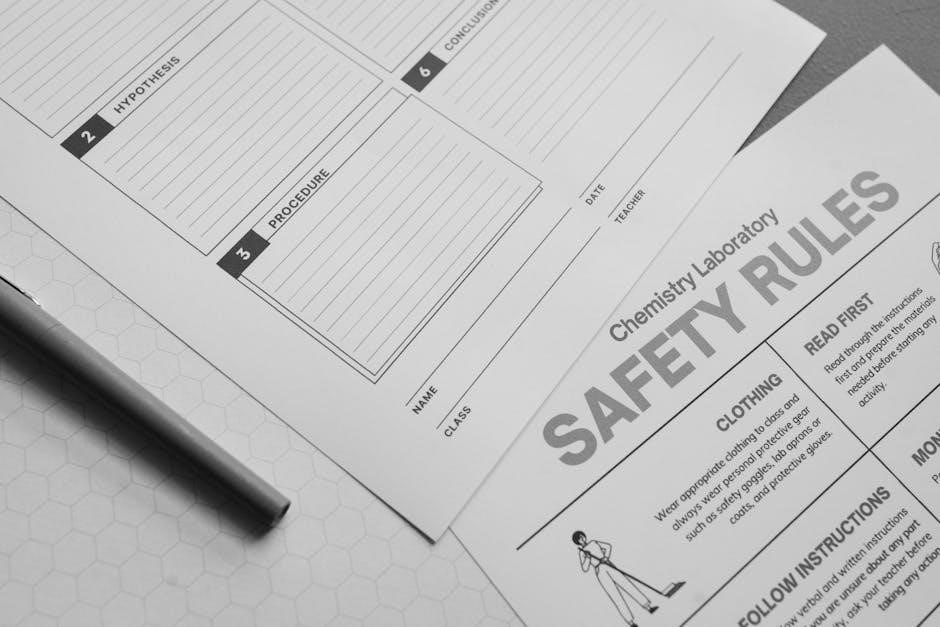
Common Mistakes When Adding and Subtracting Fractions with Unlike Denominators
Common errors include forgetting to find a common denominator‚ incorrectly adding or subtracting denominators‚ and not simplifying the final answer. These mistakes can lead to incorrect results.
Forgetting to Find a Common Denominator
One of the most frequent errors when adding or subtracting fractions with unlike denominators is forgetting to find a common denominator. Without a common base‚ fractions cannot be accurately combined. Many students mistakenly add or subtract the numerators directly‚ ignoring the denominators‚ which leads to incorrect results. To avoid this‚ always identify the least common denominator (LCD) first and convert each fraction to an equivalent fraction with the LCD. For example‚ when adding 1/2 and 1/3‚ the LCD is 6. Convert 1/2 to 3/6 and 1/3 to 2/6‚ then add the numerators: 3/6 + 2/6 = 5/6. Always double-check to ensure denominators are the same before proceeding with calculations to prevent this common mistake.
Incorrectly Adding or Subtracting Denominators
A common mistake when working with fractions is incorrectly adding or subtracting the denominators. Many students believe that to combine fractions‚ they should add or subtract the denominators along with the numerators. For example‚ when adding 1/2 and 1/3‚ some might incorrectly add the denominators (2 + 3 = 5) and the numerators (1 + 1 = 2)‚ resulting in 2/5. This is a critical error because denominators represent the whole and should not be altered during addition or subtraction; Instead‚ students must find a common denominator and adjust the numerators accordingly. Always remember: only the numerators are added or subtracted‚ while the denominator remains consistent after conversion. This mistake can lead to incorrect results‚ so it’s essential to focus on proper fraction conversion before performing operations. Regular practice with worksheets helps reinforce this concept and reduces errors. Always double-check your work to ensure denominators remain unchanged during calculations.
Not Simplifying the Final Answer
One of the most frequent errors when adding or subtracting fractions with unlike denominators is failing to simplify the final answer. After finding a common denominator and performing the operation‚ many students overlook the crucial step of reducing the fraction to its simplest form. For instance‚ if the result is 4/8‚ it should be simplified to 1/2. Not simplifying can lead to unnecessary complexity in further calculations and make the answer harder to interpret. Always check if the numerator and denominator have a common factor and divide them by that factor. This ensures the fraction is in its most basic form. Regular practice with worksheets helps develop the habit of simplifying‚ making math operations more efficient and accurate. Simplifying is a fundamental skill that improves with consistent effort and attention to detail;

Real-World Applications of Adding and Subtracting Fractions with Unlike Denominators
- Cooking and Baking: Adjusting recipes requires adding or subtracting fractions of ingredients.
- Shopping and Budgeting: Calculating discounts or splitting costs involves fractions.
- Crafts and DIY Projects: Measuring materials precisely often demands fractional math.
Cooking and Baking
Cooking and baking frequently involve adjusting recipes‚ requiring the addition and subtraction of fractions with unlike denominators. For instance‚ doubling a recipe may demand adding 1/2 cup and 1/4 cup of sugar‚ while halving it might involve subtracting 3/4 teaspoon from 1/2 teaspoon of salt. Converting between units‚ such as cups to tablespoons‚ also necessitates fractional math. These skills are essential for achieving precise measurements‚ ensuring dishes turn out correctly. Worksheets provide valuable practice‚ helping cooks and bakers master these calculations with confidence. Whether scaling recipes up or down‚ understanding how to work with unlike fractions is a key culinary skill.
Shopping and Budgeting
Shopping and budgeting often require adding and subtracting fractions with unlike denominators. For example‚ comparing prices of items in different package sizes involves calculating unit costs‚ which may involve fractions. Understanding how to add or subtract fractions helps in making informed purchasing decisions. Additionally‚ coupons and discounts often involve fractional calculations‚ such as 1/3 off or 1/4 discount‚ which must be applied to prices accurately. Budgeting also requires managing expenses‚ where fractions of income are allocated to different categories. Practicing with worksheets ensures accuracy in these calculations‚ helping individuals save money and make smart financial decisions. Mastering this skill is essential for effective money management and financial literacy.
Crafts and DIY Projects
Crafts and DIY projects often involve measuring materials‚ such as fabric‚ paint‚ or ingredients‚ where fractions are essential. Adding and subtracting fractions with unlike denominators is crucial for adjusting patterns‚ mixing colors‚ or scaling recipes. For example‚ a sewing project might require cutting fabric into pieces of 1/4 yard and 3/8 yard‚ necessitating precise calculations. Similarly‚ DIY recipes for paints or cleaning solutions often involve combining fractions with different denominators. Practicing with worksheets ensures accuracy in these measurements‚ preventing waste and ensuring projects turn out as intended. Mastering this skill enhances creativity and precision in crafting‚ making it a valuable tool for DIY enthusiasts. This practical application makes learning fractions both fun and rewarding‚ fostering a deeper appreciation for math in everyday activities.
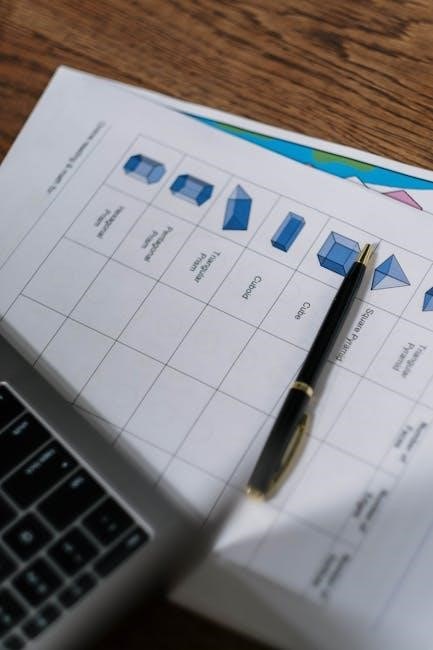
Visual Aids for Understanding Fractions with Unlike Denominators
Visual aids like fraction bars and pie charts help students compare and contrast fractions with different denominators. These tools simplify complex concepts‚ making fractions more tangible and easier to understand.
Using Fraction Bars
Fraction bars are a powerful visual tool to help students grasp the concept of fractions with unlike denominators. By representing fractions as shaded or unshaded portions of a bar‚ students can easily compare and understand the relationship between different fractions. For example‚ aligning 1/4 and 1/2 on a fraction bar illustrates how they relate in size‚ making it easier to see how to convert them to equivalent fractions with a common denominator. This hands-on approach allows learners to visualize operations like adding or subtracting fractions‚ breaking down complex steps into manageable parts. Fraction bars also help students recognize patterns and relationships‚ building a strong conceptual foundation for more advanced fraction problems.
Creating Pie Charts
Creating pie charts is an engaging way to visualize fractions with unlike denominators. By dividing a circle into sections representing different fractions‚ students can see how parts relate to the whole. This tool helps in comparing fractions‚ understanding their proportions‚ and identifying common denominators. For instance‚ a pie chart can illustrate how 1/4 and 1/2 occupy different portions of the circle‚ aiding in converting them to equivalent fractions. Pie charts also make adding and subtracting fractions intuitive‚ as students can see the combined or remaining portions. This hands-on method enhances understanding and retention‚ especially for visual learners‚ making complex fraction operations more accessible and enjoyable.
Visualizing with Real-Life Objects
Visualizing fractions with real-life objects helps students grasp the concept of adding and subtracting fractions with unlike denominators. Using everyday items like pizzas‚ cakes‚ or fruits‚ students can see how fractions represent parts of a whole. For example‚ cutting a pizza into slices demonstrates how 1/4 and 1/2 can be compared and combined. This hands-on approach makes abstract concepts concrete‚ allowing students to physically see the process of finding common denominators and simplifying results. By manipulating tangible objects‚ learners develop a deeper understanding of fraction operations‚ making it easier to apply these skills to worksheet problems and real-world scenarios. This method is particularly effective for visual and kinesthetic learners‚ enhancing engagement and retention of math concepts.

Tips for Parents and Teachers
Encourage interactive learning by incorporating games and real-life examples. Provide immediate feedback to help students understand their mistakes. Use fraction worksheets to reinforce concepts and track progress‚ ensuring a strong foundation for advanced math skills. Regular practice with PDF resources fosters confidence and proficiency in adding and subtracting fractions with unlike denominators.
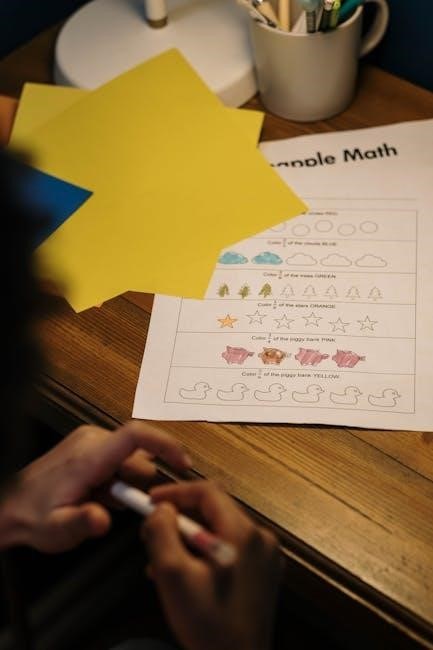
How to Make Learning Fractions Fun
Engage students with interactive activities like fraction scavenger hunts or cooking recipes requiring precise measurements. Use visual aids such as fraction bars or real-life objects to demonstrate concepts. Incorporate games like “Fraction War” or “Fraction Bingo” to make practice enjoyable. Encourage storytelling by creating narratives involving fractions‚ helping students relate abstract concepts to everyday situations. Utilize online tools or apps that offer interactive fraction lessons. Collaborative learning through group activities or peer teaching can also make the process more dynamic and less isolating. Celebrate progress with fun rewards to maintain motivation and confidence in mastering fraction operations.
Using Games and Activities
Incorporate engaging games like “Fraction War” or “Fraction Bingo” to make learning interactive and enjoyable. These activities transform complex concepts into fun challenges‚ fostering healthy competition and teamwork. Online tools and apps offer interactive fraction lessons‚ allowing students to practice addition and subtraction with unlike denominators in a dynamic way. Hands-on activities‚ such as creating fraction art or using real-life objects‚ help visualize fraction operations. Games and activities not only reinforce mathematical skills but also build confidence and problem-solving abilities in a relaxed and motivating environment. They provide an effective way to apply fraction concepts to real-world scenarios‚ making learning both productive and entertaining.
Providing Immediate Feedback
Immediate feedback is crucial for effective learning‚ especially when mastering fraction operations. By reviewing worksheets and exercises promptly‚ students can quickly identify and correct mistakes. Printed PDF answers or digital tools enable self-assessment‚ fostering independence and confidence. Teachers can use completed worksheets to address common errors‚ ensuring misconceptions are resolved early. Immediate feedback also highlights progress‚ motivating students to continue improving their skills. Regular review sessions help reinforce correct methods‚ making the learning process more efficient and engaging. This approach ensures students grasp the fundamentals of adding and subtracting fractions with unlike denominators‚ building a strong foundation for future math concepts.
Mastering adding and subtracting fractions with unlike denominators is achievable with practice. Utilize free PDF worksheets for consistent improvement‚ ensuring confident handling of more complex math problems ahead.
Key Takeaways

Adding and subtracting fractions with unlike denominators requires finding a common denominator‚ converting fractions‚ and simplifying results. Practice with worksheets enhances understanding and proficiency. These skills are essential for real-world applications like cooking‚ shopping‚ and crafts. Consistent practice using PDF resources builds confidence and accuracy. Mastering this concept lays a strong foundation for advanced math topics. Regular use of worksheets ensures students can handle complex problems effectively. The ability to simplify fractions is crucial for accurate results. Worksheets provide structured exercises to reinforce learning. By following step-by-step processes‚ students can master these skills and apply them in various situations.
Encouragement to Continue Practicing
Consistent practice is key to mastering the skill of adding and subtracting fractions with unlike denominators. With regular effort‚ students can build confidence and accuracy‚ reducing errors over time. The availability of worksheet resources‚ such as PDF files‚ makes it easy to practice anywhere‚ anytime. Encourage learners to embrace challenges and view mistakes as opportunities to grow. Celebrate progress‚ no matter how small‚ to keep motivation high. Remember‚ persistence leads to mastery‚ which is essential for tackling more complex math problems in the future. Keep practicing‚ and soon these skills will become second nature!



